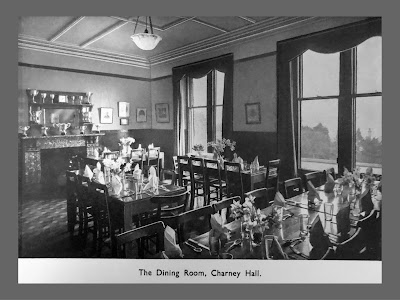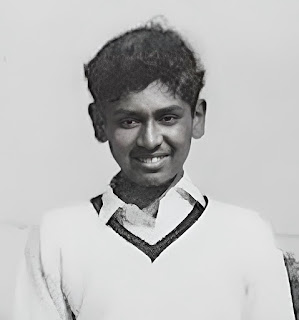CHARNEY HALL Prospectuses
Post updated Aug 2021
Here is what I believe may be the first prospectus published by the new owners of Charney Hall, Maxwell Duncan and Raymond Hirst. They acquired the school in 1937 from Conrad Podmore, the founder’s son who died before completion of the sale.
The prospectus refers to the ‘modern open-air sea-water swimming-pool’ and the school fees of 45 guineas a term, a bargain today, equates to £9700 a year at current costs. Some may say ‘excellent value for money’ especially when the fees for a public school education are now in the order of 30K a year.
There is a subtle reminder that the cricket and football pavilions had been donated by a parent, perhaps sowing the seed of future bequests.
The photograph of the Memorial Hall may trigger memories of what actually was displayed on those walls!
I can honestly say that I do not remember vases of daffodils in season and carefully folded napkins, artfully set against glasses on dining tables - well before my time!
I’ve reproduced the prospectus verbatim and we have to thank Alison Lebègue, Raymond Hirst’s granddaughter and Esther Hirst’s daughter for sourcing this historic document.
CHARNEY HALL, GRANGE-OVER-SANDS.
J. R. Hirst M.A. W. Maxwell Duncan M.A.
(Exeter College, Oxford). (Pembroke College, Oxford)
Honour School of Modern Languages.
SITUATION
Charney Hall is a Boys Preparatory School limited in number to 40 boys, inspected and recognised as efficient by the Board of Education. The usual age of entry is eight or nine. Parents are urged not to delay the age of entry as late as 10, except under unusual circumstances such as ill-health. Long experience has shown that the year thus lost is very hard to make up and is a great handicap to the boy.
The school stands over 300 feet above the sea in a bracing position. It is sheltered from the east and north winds, and has a very fine view over the bay. Just behind the school the open fell rises to a height of 700 feet, forming an ideal rambling ground for boys. All school walks can therefore be taken in open moorland and woodland country, and walks along the road are comparatively rare.
Grange is situated at the head of Morecambe Bay on the outskirts of the Lake District, amid very picturesque scenery, and has a very high reputation as a health resort. In records of bright sunshine it stands far ahead of most places in the North of England. It is easily accessible to by rail, being on the LMS Railway (Furness Branch); on certain trains every day there are through carriages to and from London (Euston) and Leeds.
CURRICULUM
Boys are prepared for entry to the Public Schools and the Royal Navy. Special attention is paid to preparing promising boys for Entrance Scholarships. The ‘Honours Board’ is a satisfactory one and includes scholarships gained at nearly all the well-known Public Schools. Since 1890 over fifty scholarships have been won.
The curriculum includes ordinary English subjects, Mathematics, French and Latin. Greek or German may be taken when the pupil is sufficiently advanced, but neither subject is compulsory. Carpentry and Drawing are now a part of the regular School work and learnt by all boys. These were once Extra Subjects and learnt only by a few, but the increasing importance in modern education of training a boy’s hand and eye as well as his brain has made it necessary to find room for these subjects as part of the regular school work for all. Similarly, two periods per week are given to Elementary Science and Nature Study.
A Singing Class is part of the regular school curriculum, but Instrumental Music and Dancing are optional subjects and are charged as extras.
BUILDINGS
Since Charney Hall was built as a school, the buildings and playing-fields have been considerably added to, and modern conveniences installed, including adequate fire-escapes and fire-extinguishers. The drainage and sanitary arrangements are regularly tested and most satisfactory, and the Grange water is exceptionally pure, been derived from the slate hills about four miles away.
The outbuildings include, besides Joiner’s Shop and Music Room, a large Gymnasium which is used not only for Drill and Gymnastics but as a general Playroom, where indoor cricket and football, and rollerskating are favourite amusements.
For reading or quiet games there is a large War Memorial Hall built in memory of the Old Boys who fell in the Great War. Here boys may play billiards, bagatelle, chess, draughts or at certain times listen to the wireless. The Hall contains a large, well-stocked library of boys’ books to which additions are continually being made.
The Lodge, a small house in the school grounds built for its present purpose in 1928, is normally an annexe to the school in charge of a Master or a Matron, but in the event of any epidemic it becomes at once the school sanatorium.
DOMESTIC ARRANGEMENTS
The domestic arrangements are under the direct supervision of Mrs. Duncan, and assisted by Mrs. Hirs, who holds a Diploma in Domestic Science and Child Nursing. There are two Boys’ Matrons (one of whom is a trained nurse).
There are two Dormitories for the senior boys, while the younger boys share smaller bedrooms, none of which contains more than five beds.
The Laundry is on the premises and all washing is done at the school.
RELIGIOUS INSTRUCTION
Morning and evening prayers form an integral part of school life. The School attends Morning Service at the Parish Church of Saint Paul’s every Sunday. Furthermore it is the object of the School that no boy should leave without a thorough knowledge of both Old and New Testaments.
GAMES
The Grounds (to which large additions were made in 1933, the Schools Jubilee year), adjoin the house, and their total extent is slightly over seven acres. Each of the two playing fields has a pavilion, the gift of a former parent. Special attention is given by all masters to the coaching of boys in cricket and football. Lawn Tennis is played by the senior boys only, in their spare time, not as a substitute for cricket.
By special arrangement with the Grange Urban District Council the School has the exclusive use of the modern open-air sea-water swimming-pool, and the services of the Council’s Swimming Instructor, for two periods per week throughout the Summer Term, or more if desired.
The school routine includes a quarter of an hour’s Physical Training every day (out-of-doors whenever possible) as a break in the middle of morning school, as well as regular instruction in the School Gymnasium.
FEES ETC
The fees (payable in advance) are 45 guineas per term. Extras include; Instrumental Music £2.12s.6d, Dancing £2.2.0d, Laundry £1.5s.0d
A fee of £2.2s.0d is charged for Household Linen when a boy enters the school. This provides for sheets, all towels, table napkins etc., used by the boy throughout his career at Charney Hall.
The ‘School Fees Insurance Scheme’ now adopted by so many schools, is in force at Charney Hall. By this scheme parents may, if they wish, insure against loss of fees owing to absence from school through illness, by payment of a small premium each term, which is charged in the term’s account.
The parents or guardians of the boy are required to give a term’s notice of his removal from the school.
Every boy must bring with him at the beginning of each term a certificate that he has been free from contact with any infectious illness during the preceding holidays.
Two later prospectus are shown below which were obtained from Barrow Archive Centre, Cumbria County Council. File ref: BDS/16/4/1-7
The first was produced when Maxwell Duncan was still headmaster with Messrs. Fawcett and McCullagh supporting him as partners. The date of publication is not shown but it must be later than the completion of the school’s new swimming pool in 1964 as one of the photographs depicts Maxwell Duncan overseeing the pool. This takes place after the retirement of Raymond Hirst in 1960.
We can therefore assume that this publication was printed and in use between the mid to late 1960s.
The second prospectus, signed by Messrs. Fawcett and McCullagh as joint headmasters, is a much more proactive document being more modern in appearance, short and concise. It was designed to be issued with a flyer containing details of the school fees - these appear very reasonable when compared with current prices. But we must remember the effects of inflation which is a subject highly likely to be discussed in the near future…
Bearing in mind that the school closed and was demolished in 1973, there is a certain urgency attached to this brochure. Perhaps it was sent out at a time when pupil numbers were dropping and the school needed to ensure a quick response to any enquiries from prospective boys’ parents.
A loose leaf print of a pen and ink sketch of the school included in the prospectus
































Comments